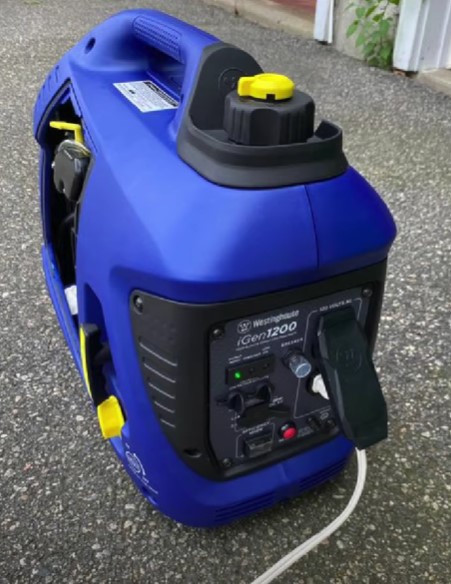Inverter generators may or may not require grounding, depending on usage. When using extension cords, grounding isn’t necessary unless specified in the owner’s manual. However, when connecting to an electrical panel, a ground rod (at least 8ft deep) is needed, following federal, state, and local regulations.
Inverter generators have revolutionized the way we use portable power. They provide stable, clean energy suitable for sensitive devices, all within a compact and efficient package.
But a question that often comes up is: Do inverter generators need to be grounded? In this article, we will explore the grounding requirements for inverter generators.
Do Inverter Generators Need to Be Grounded?
The grounding requirements for an inverter generator are generally the same as those for any other type of generator. Whether or not you need to ground an inverter generator will depend on how you are using it.
As a rule of thumb, if the generator is a standalone system (i.e., it is not connected to a house through a transfer switch), it needs to be grounded. This is because a standalone system may not have any other path to the ground, and grounding it can help prevent electrical shock in the event of a fault.
If the inverter generator is connected to a house through a transfer switch, it generally does not need to be grounded. The house’s grounding system is typically sufficient.
Regardless of the type of generator, always refer to the manufacturer’s guidelines regarding grounding. If you’re unsure, it’s best to consult with a qualified electrician.
When inverter generator Grounding is Necessary?
Grounding is an important aspect of operating any electrical system, including inverter generators. The key factor determining whether the grounding is necessary is the configuration of the generator system.
In general, if an inverter generator is being used as a standalone power source, grounding is necessary. In this context, standalone means the generator is not connected to a house or another building’s electrical system. Grounding such a generator helps to prevent electrical shock by providing a safe path for the electrical current to follow in case of a fault.
On the other hand, if the inverter generator is connected to a house or building’s electrical system through a transfer switch, it may not need to be grounded separately. This is because the house or building’s grounding system can serve the purpose, of providing a path for the electrical current to ground in case of a fault.
Remember, always consult the manufacturer’s instructions and local regulations regarding the grounding of your specific inverter generator model. When in doubt, it’s a good idea to reach out to a professional electrician to ensure you’re following best safety practices.
Instances When Grounding May Not Be Necessary
In some cases, grounding an inverter generator may not be necessary. If the generator is connected to a house or building through a transfer switch, the grounding system of the building typically suffices. Modern inverter generators often have in-built grounding systems as well, negating the need for additional grounding in certain cases. However, always refer to the manufacturer’s guidelines regarding grounding.

How to Ground an Inverter Generator while Camping?
Steps to Ground an Inverter Generator during Camping:
- Identify a Suitable Spot for the Grounding Rod: The first step is to find a suitable spot to place your grounding rod. This should be near your generator, but not in a place where people are likely to trip over it.
- Drive the Grounding Rod into the Ground: Use a hammer to drive the copper grounding rod into the ground. Try to ensure that at least three feet of the rod is below the surface.
- Prepare the Grounding Wire: Using your wire strippers, strip the insulation off both ends of the copper grounding wire.
- Attach the Grounding Wire to the Rod: Connect one end of the grounding wire to the grounding rod. This should be done using a grounding clamp. Tighten the clamp securely using a wrench.
- Attach the Grounding Wire to the Generator: Connect the other end of the grounding wire to the grounding bolt on your generator. If you’re unsure which bolt this is, consult your generator’s manual. Tighten the grounding wire onto the bolt securely using a wrench.
- Check Your Grounding System: Once the grounding wire is securely connected at both ends, double-check your work. The grounding wire should be securely attached to both the grounding rod and the grounding bolt on your generator.
- Use the Generator Safely: With your generator now properly grounded, you can operate it safely, and securely in the knowledge that you are protected against electrical faults.
If you are not comfortable doing this yourself or if you are unsure about any of the steps, consult with a professional electrician. Furthermore, always refer to the manufacturer’s instructions, as there might be model-specific procedures or precautions you need to follow.
Do I Need to Ground My Generator When Camping?
When camping with a portable generator, grounding is usually not necessary. Here’s why:
- Portable Design: Camping generators are designed to be mobile and used in various locations. They are not intended for permanent installations like home generators. As such, they are engineered to operate safely without the need for grounding.
- No Fixed Electrical System: Campgrounds and outdoor settings do not have a fixed electrical system like a home or building. In a permanent electrical system, grounding helps protect against faults and lightning strikes. However, in a camping scenario, the absence of a fixed system reduces the need for grounding.
- Safety Features: Modern camping generators are equipped with safety features like Ground Fault Circuit Interrupters (GFCIs) that provide protection against electrical shocks. These features enhance safety without requiring additional grounding.
- Manufacturer Guidelines: Always refer to the manufacturer’s instructions and guidelines provided in the generator’s manual. They will specify how to safely set up and operate the generator, including any grounding requirements specific to that model.
While grounding may not be necessary for most camping generators, it’s crucial to take other safety precautions:
- Proper Ventilation: Place the generator in a well-ventilated area to prevent carbon monoxide buildup. Never run it inside a tent or enclosed space.
- Stable Placement: Ensure the generator is on a stable, level surface to prevent tip-overs.
- Extension Cords: Use outdoor-rated extension cords to connect appliances, and make sure they are in good condition.
- Maintenance: Regularly maintain your generator, checking for fuel leaks, loose connections, and clean air filters.
While you typically do not need to ground your camping generator, it’s essential to prioritize safety by following manufacturer guidelines, proper setup, and maintenance practices to ensure a safe and enjoyable camping experience.

Can I Use a Generator Without Grounding?
Yes, you can use a generator without grounding in many situations. Most portable generators are designed to operate safely without the need for grounding. However, there are exceptions, and it’s essential to consider the following:
- Manufacturer’s Instructions: Always follow the manufacturer’s guidelines and instructions provided in the generator’s manual. Some generators may have specific grounding requirements based on their design and intended use.
- Type of Generator: Standby generators, which are often used as a backup power source for homes, may require grounding as they are part of a permanent electrical system. In contrast, portable generators used for camping or temporary power typically do not need grounding.
- Safety Features: Portable generators often include safety features like Ground Fault Circuit Interrupters (GFCIs) to protect against electrical shocks. These features enhance safety without relying on grounding.
- Local Regulations: Be aware of any local, state, or national regulations related to generator usage. In some cases, local codes or ordinances may specify grounding requirements, so it’s essential to comply with them.
- Specific Applications: In certain applications, such as connecting a generator to a home’s electrical panel using a transfer switch, grounding may be necessary to ensure safe and proper operation. In such cases, it’s advisable to consult a licensed electrician.
Related Post
How to Connect Generator to House Without Transfer Switch?
Final Thoughts
Understanding whether you need to ground your inverter generator is crucial for safe operation. If your generator is a standalone system, grounding is typically necessary. Always refer to the manufacturer’s guidelines and consider professional advice to ensure safe and effective grounding. When it comes to handling electricity, safety should always be your foremost concern.
Recent Posts
Yes, synthetic oil can generally be used in generators. It offers superior lubrication, improved resistance to temperature variations, and longevity compared to conventional oil, which can enhance...
In today's digital age, our dependency on computers and other electronic devices is undeniable. But what happens when a power outage occurs? This is where generators come in. However, is it safe to...
